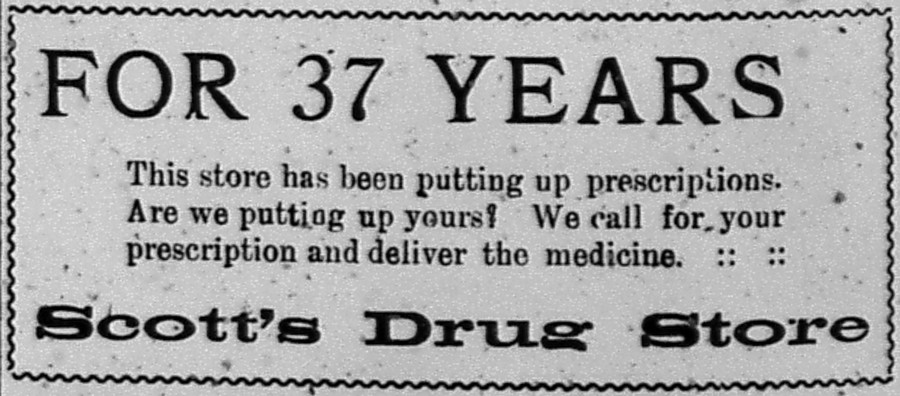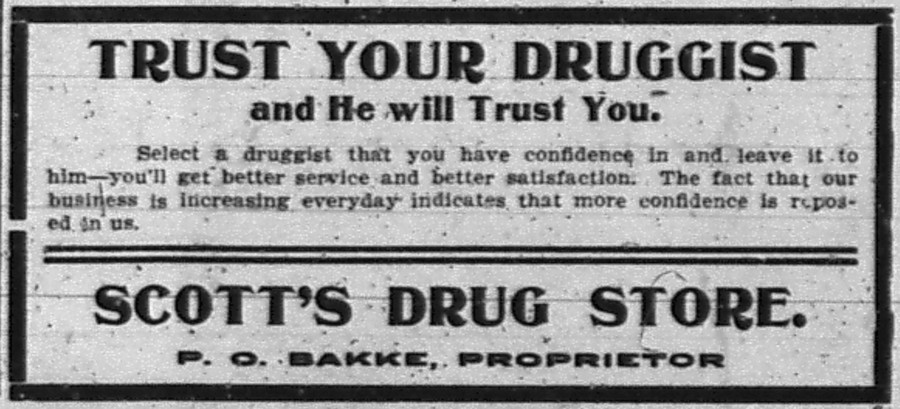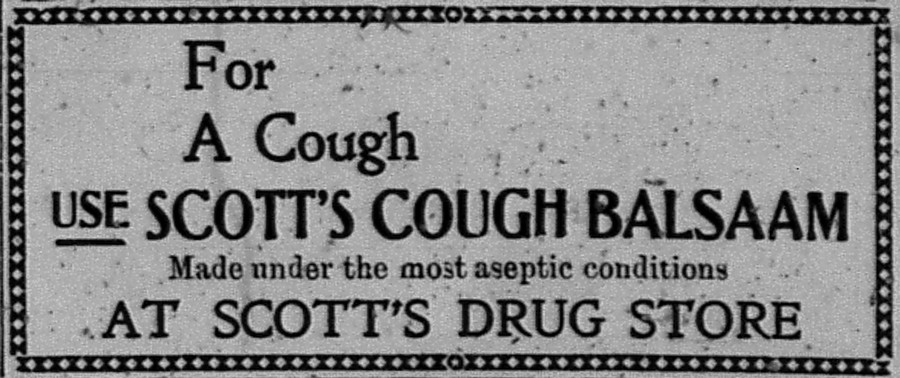30 Oct 2021, last revised 31 May 2024

A. J. Scott not only ran a drug store in Hancock, but he was also a prominent member of Hancock's early history. Bottles associated with the drug store were discovered after the publication of Old Copper Country Bottles in 1978, which is a testament to their rarity. They bear the names A. J. Scott and Scott's Drug Store.
Archibald James Scott was born on 24 Jan 1848 in Ontario, Canada (2), and was of Scottish descent (19). He lost his parents as an infant (3,4) and immigrated to the U.S. (16) to be raised by his uncle who's work as a railroad contractor moved them to several states (4). He then attended school in Wisconsin (4). In 1863, at the age of 15, he enlisted as an orderly in the Civil War as part of the 52th Wisconsin Volunteer Infantry and served until Jan 1865 (4). He moved to Houghton County in early 1866 and worked at a saw mill (3). Then in 1867 (4), he worked as a clerk in M. J. McGurrin's drug store (3), which opened in Aug or Sep of 1865 (14). He worked at the drug store until it was destroyed along with the city of Hancock by the Apr 1869 fire (3,4). The fire started in a French saloon when a stove apparently was overturned at the end of an all-night dance (15). Instead of extinguishing the flames, the party left and the fire quickly engulfed the building and spread (15). Within a scorched 12-acre area, 150 buildings, including every store in town, were lost (15).
Shortly after the fire, in 1869, Scott opened his own drug store next to where the First National Bank was later located (3,4,10). The store was on Quincy St. at the location Dr. Gallagher later occupied (10). The 1905 Polk directory specified the address for this location as 105 Quincy St. (1) and the 1907 Sanborn map showed this address to be on the north side of the street, three units west of Reservation St. An article announcing Scott's retirement from the drug business claimed that during the summer of 1869, Scott had the only drug store in the Copper Country (10), but we find T. Smith was also operating at that time.

Holland directory ad - 1887
After a year, Scott moved to Tezcuco St. in the building later occupied by John Stenbeck's saloon (7,10), which was at 308 Tezcuco St. (1). The 1907 Sanborn map showed this address to be on the west side of the street, between Hancock St. and Quincy St. In Jun 1872, Scott was building a new store (18), which appears to be the location described as being on the corner of Hancock St. and Tezcuco St. (10). This location was later occupied by the Stockholm liquor store (10). In 1880, Scott built the Scott Block (3) and moved his store to that location (10). The 1887 Holland directory specified the address as 210 Quincy St. (8). Re-numbering of the street was not reflected on the Sanborn maps until the 1907 version, which showed that the previous address was 441 Quincy St. We find that this location housed the drug store in the Scott Block on the south side of Quincy St, between Ravine St. and Tezcuco St.

Sanborn map - Jun 1900
Scott served as more than just a druggist for Hancock. He was the village assessor for four years, and then the village supervisor for 26 years (3,4). He served as fire chief of Hancock from the inception of the fire department in 1870 (3). He was superintendent of the City Water Works and installed the first pumping station in 1890 (3). He served as president of the village of Hancock, and was elected as the first mayor of the city, serving for 14 years (3). He was vice president of the First National Bank, a directorate of the Superior Trust Co., president of the Eva Mining Co., and a director of the Hancock Loan, Mortgage and Insurance Co. (3). He built the Hotel Scott, the Scott Block, several other buildings, and 20 or more dwellings (3).

Newspaper ad - Jan 1900

Newspaper ad - Jul 1901
In Mar 1904, Scott announced that he had disposed of his drug business and P. O. Bakke of Milwaukee would take over the business on May 01, but he would retain the old name of "Scott's drug store" (10). The 1905 Polk directory listed Peter O. Bakke as proprietor of "Scott's Drug Store" at the 210 Quincy St. address (1).

Newspaper ad - Jul 1904

Newspaper ad - Oct 1904
Bakke's time running the drug store was short-lived. In a sudden turn-of-events, on 05 Aug 1905, Scott resumed possession of the property (6). Bakke arrived to open up the store as usual, but found it locked with Scott inside (6). It turns out when Scott sold the store to Bakke, Bakke paid half of the price, $2,000, as a down payment (6). But business under Bakke was not as successful as anticipated and subsequent payments went unpaid (6). No bill of sale was thus given to Bakke (6). Scott informed Bakke the night prior that he wanted the business back (6). Newspaper advertisements changed back to stating "A. J. Scott" with only one ad stating "Scott's Drug Store". The 1907 directory noted that Bakke had moved to Minneapolis, MN (11).

Newspaper ad - Sep 1905

Newspaper ad - Oct 1905
In Mar 1906, Scott announced that, in the course of a few months, he would dispose of his stock, retire from the drug business in Jun, and leased his store room to N. A. Metz who would open a clothing store (9,5). After repossessing the store from Bakke, Scott continued the business in order to have time to sell off his stock (9). The building was then labeled as a clothing store on the 1907 Sanborn map.
After retiring as a druggist, Scott continued to be the vice-president of the First National Bank of Hancock (12,13) and proprietor of Hotel Scott (3,13). He was listed as the president of the Park Brewing Co. in the 1907 and 1910 directories (11,12) and then resigned from the position in 1911 (17). He died in 1915 at the age of 66-67 and was buried in Lakeside Cemetery, Hancock (2).
One (damaged) bottle and shards of a HORSE LINIMENT bottle bear the name, "A. J. SCOTT" and thus, can be attributed to Scott's time as proprietor. Even though A. J. Scott's drug store was often referred to as "Scott's drug store", this name was not formally listed in the Polk directory or used in newspaper ads until Bakke became proprietor. Thus, the bottle embossed with SCOTT'S DRUG STORE most likely came from Bakke's time as proprietor. The Scott's Drug Store bottle is one of only two Copper Country bottles that bears the mark of Whitney Glass Works.
Citations
- R. L. Polk & Co. 1905. Houghton County Directory 1905-05. R. L. Polk & Co., Publishers. Detroit, MI.
- Find a Grave. accessed Oct 2021. Archibald James Scott. findagrave.com/memorial/167487804/archibald-james-scott
- Sawyer, A. L. 1911. A History of the Northern Peninsula of Michigan and its People. The Lewis Publishing Company. Chicago, IL.
- anonymous. 1883. History of the Upper Peninsula of Michigan. The Western Historical Company. Chicago, IL.
- anonymous. (1906, Mar 03). Will lease store. The Evening Journal (Hancock, MI). p. 8.
- anonymous. (1905, Aug 05). Takes drug store. The Evening Journal (Hancock, MI). p. 8.
- J. E. Scripps and R. L. Polk & Co. 1873. Michigan State Gazetteer and Business Directory for 1873. Tribune Book and Job Office. Detroit, MI.
- Holland, A. H. 1887. 1887-8 Hand-book and Guide to Hancock, Mich. Mining Journal Book and Job Print. Marquette, MI.
- anonymous. (1906, Mar 04). A. J. Scott will give up business. The Daily Mining Gazette (Houghton, MI). p. 4.
- anonymous. (1904, Mar 29). A. J. Scott sells out. The Copper Country Evening News (Calumet, MI). p. 3.
- R. L. Polk & Co. 1907. Houghton County Directory 1907-08. R. L. Polk & Co., Publishers. Detroit, MI.
- R. L. Polk & Co. 1910. 1910 Calumet, Houghton, Hancock and Laurium Directory. R. L. Polk & Co., Publishers. Detroit, MI.
- R. L. Polk & Co. 1912. 1912 Calumet, Hancock, Houghton and Laurium Directory. R. L. Polk & Co., Publishers. Detroit, MI.
- anonymous. (1865, Sep 02). New drug store. Portage Lake Mining Gazette (Houghton, MI). p. 3.
- anonymous. (1869, Apr 25). The burning of Hancock, Mich. The New York Times. p. 1.
- anonymous. 1900. Men of Progress: Embracing Biographical Sketches of Representative Michigan Men with an Outline History of the State. The Evening News Association. Detroit, MI.
- anonymous. (1911, May 18). Park Brewery meeting. The Calumet News (Calumet, MI). p. 1.
- anonymous. (1872, Jun 13). Hancock items. Portage Lake Mining Gazette (Houghton, MI). p. 3.
- anonymous. (1890, Oct 21). untitled. Torch Lake Times (Lake Linden, MI). p. 3.
top: cork top - tooled
base outline:

date: c.1885-c.1895
capacity - H x W - base mark -rarity:
2 oz - 10.4 x 4.3 cm - W. T. & Co / DA - no known whole example
- capacity not marked on bottle
top: cork top - tooled
base outline:

date: 1904-1906
capacity - base mark -rarity:
1 oz -
 - extremely rare
- extremely rare2 oz -
 - extremely rare
- extremely rare4 oz -
 - extremely rare
- extremely rare- capacity marked above plate



